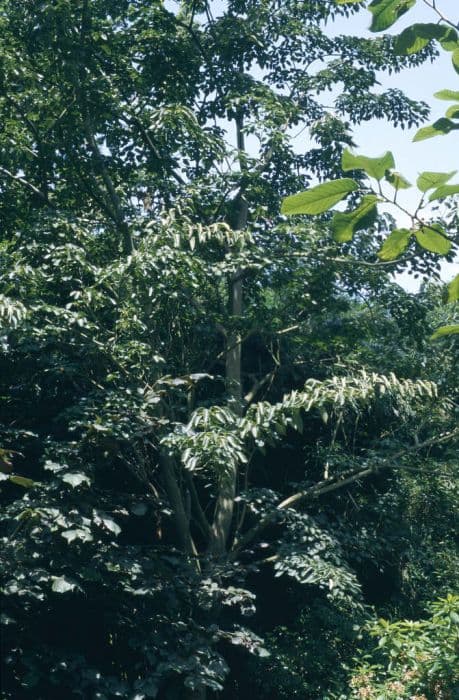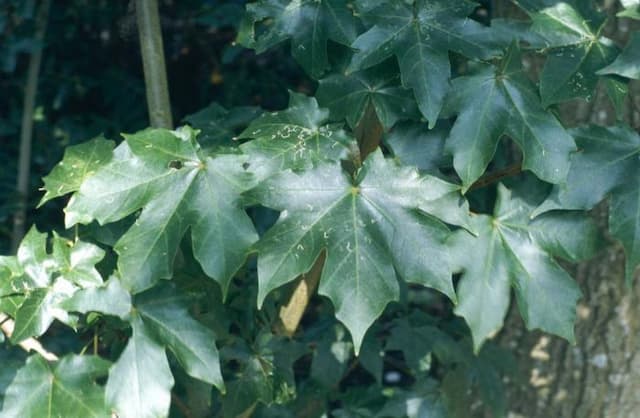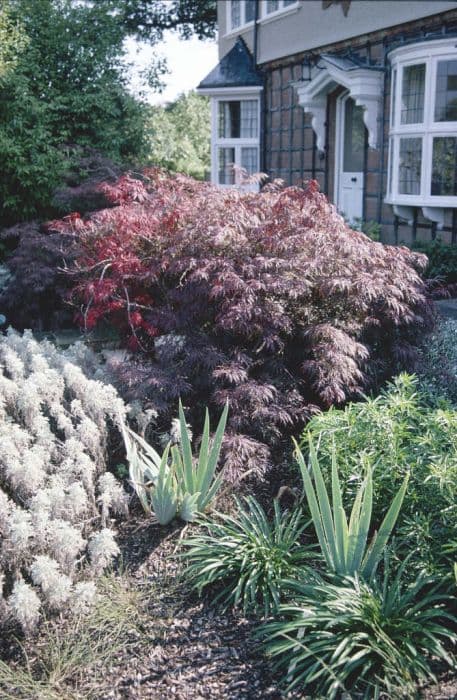Vine maple Acer circinatum

ABOUT
Acer circinatum, commonly known as the Vine Maple, is a striking plant with a multi-stemmed, often shrubby appearance. The leaves of this plant are its most distinctive feature; they are palmate, meaning they resemble the shape of an open hand with outstretched fingers, and are usually 7 to 9 lobed. Each leaf has a circular shape with a graceful, sinuous edge and a pointed tip, adding an elegant aesthetic to the plant's overall look. These leaves are typically a bright green color, which shifts to a vivid array of oranges, reds, and yellows during the fall, offering a spectacular autumn display. The structure of the Vine Maple is somewhat open and airy, with branches that spread outwards and sometimes droop down, giving it a soft, layered effect. The plant's bark contributes to its visual interest throughout the year, providing a smooth surface that ranges from greenish to reddish-brown, often becoming more colorful and striking in the colder months. Spring brings additional beauty to the Vine Maple, as it produces small, charming flowers that hang in clusters. These blossoms are red or purple and complement the bright green of the new leaves. Following the flowers, the Vine Maple produces winged seeds that hang in pairs and can be seen twirling to the ground when they detach in the wind. All these characteristics together make the Vine Maple a delightful and picturesque plant with multi-season appeal.
About this plant
 Names
NamesFamily
Sapindaceae.
Synonyms
Vine Maple, Mountain Maple, Cascade Maple.
Common names
Acer circinatum.
 Toxicity
ToxicityTo humans
The plant commonly known as Vine Maple (Acer circinatum) is not generally considered toxic to humans. It does not have any significant toxic properties that would cause poisoning if ingested in normal quantities. However, like any plant material, if eaten in large quantities or by individuals with specific allergies, it could potentially cause gastrointestinal discomfort or an allergic reaction.
To pets
Vine Maple (Acer circinatum) is also not known to be toxic to pets. It should not cause poisoning if your pet nibbles on the leaves or bark. Always monitor your pets around plants, as individual animals may have unique sensitivities, and consuming large amounts can potentially lead to stomach upset. If your pet displays unusual symptoms after consuming any part of the plant, it is best to consult a veterinarian.
 Characteristics
CharacteristicsLife cycle
Perennials
Foliage type
Deciduous
Color of leaves
Green
Flower color
Red
Height
10-20 feet (3-6 meters)
Spread
15 feet (4.5 meters)
Plant type
Tree
Hardiness zones
6
Native area
North America
Benefits
 General Benefits
General Benefits- Ornamental value: Acer circinatum, commonly known as the Vine Maple, is prized for its attractive foliage and fall color, making it a popular choice for ornamental landscapes and gardens.
- Shade provision: The canopy of the Vine Maple creates natural shade in gardens and parks, which can help in cooling surrounding areas and provide a comfortable outdoor space.
- Habitat for wildlife: This plant offers habitat and food for a variety of wildlife, including birds and small mammals, which feed on its seeds and find shelter in its branches.
- Soil stabilization: With its extensive root system, the Vine Maple helps in preventing soil erosion, especially in sloped areas or near water bodies.
- Native cultural significance: Indigenous peoples have historically valued the Vine Maple for various traditional uses, from crafting tools to using the wood for smoking fish.
 Medical Properties
Medical Properties- Astringent: The bark of Acer circinatum, commonly known as Vine Maple, has been historically used by some indigenous peoples of the Pacific Northwest for its astringent properties, which can help to tighten and tone tissues.
- Eye wash: Infusions made from the bark have also been used as an eye wash for sore eyes, although this usage is based on traditional practices and not supported by scientific studies.
 Air-purifying Qualities
Air-purifying QualitiesThis plant is not specifically known for air purifying qualities.
 Other Uses
Other Uses- Acer circinatum, commonly known as the Vine Maple, can be used in woodworking to create decorative pieces, such as bowls and veneers, due to its attractive grain patterns.
- The wood of the Vine Maple is sometimes utilized for making musical instruments, where its tonal qualities are appreciated, especially in the creation of woodwinds.
- Vine Maple branches are flexible and can be crafted into furniture or bentwood boxes by indigenous peoples of the Pacific Northwest.
- The tree's natural growth habit can provide habitat enhancement in gardens, offering shelter and nesting sites for birds and other wildlife.
- Due to its vivid fall colors, the Vine Maple is used in landscape photography as a subject or as a backdrop to enhance natural scenery.
- In bonsai, the Vine Maple is valued for its ability to be trained into artistic shapes and its seasonal leaf color variation.
- The sap of the Vine Maple can be tapped and reduced to make a syrup, similar to how sugar maple sap is used, albeit being less sweet and more labor-intensive.
- Vine Maple is sometimes planted in erosion-prone areas, where its root system helps stabilize the soil and prevent soil erosion.
- The tree can be used in urban forestry programs to add diversity and resilience to the urban tree canopy.
- In traditional crafts, Vine Maple twigs and thin stems are woven into baskets, mats, and other forms of decorative art.
Interesting Facts
 Feng Shui
Feng ShuiThe Vine Maple is not used in Feng Shui practice.
 Zodiac Sign Compitability
Zodiac Sign CompitabilityThe Vine Maple is not used in astrology practice.
 Plant Symbolism
Plant Symbolism- Resilience – The Vine Maple (Acer circinatum) demonstrates resilience as it can thrive in a variety of soil conditions and is robust enough to recover from environmental stresses.
- Adaptability – As a species that can grow in both sunny and shady conditions, the Vine Maple represents the ability to adapt to different circumstances in life.
- Beauty – With its striking autumn colors, the Vine Maple symbolizes natural beauty and the aesthetic pleasures of the changing seasons.
- Growth – The growth habit of the Vine Maple, both upwards and outwards, can signify personal growth and expansion of one's horizons.
- Protection – In some cultures, trees are often seen as protective entities; the dense canopy of a Vine Maple may represent shelter and safety.
 Water
WaterThe Vine Maple should be watered deeply to ensure moisture reaches the roots, but it does not require frequent waterings; allow the soil to become slightly dry between waterings. Typically, watering this plant once a week with 1 to 2 gallons of water is sufficient, depending on the climate and soil drainage. During hot periods, water may be needed more frequently, while less is required during cooler, rainy seasons. Avoid overwatering, as Vine Maple does not tolerate waterlogged conditions well.
 Light
LightThe Vine Maple prefers partial shade to full sun exposure but thrives best in dappled sunlight. The ideal spot for this plant is under the canopy of larger trees where it receives indirect light or filtered sunlight for most of the day. It can also tolerate full sun in cooler, moist climates.
 Temperature
TemperatureVine Maple is hardy and can survive a temperature range of 20 to 80 degrees Fahrenheit, tolerating cold down to about -10 degrees Fahrenheit. The ideal temperature conditions for this plant are between 60 to 75 degrees Fahrenheit, where it can grow and flourish without stress.
 Pruning
PruningPruning the Vine Maple is essential for maintaining health and shaping the plant. Pruning should be done in the late winter or early spring before new growth starts. Remove dead or damaged branches, thin out dense areas to allow light and air circulation, and cut back any growth that doesn't fit the desired shape of the plant.
 Cleaning
CleaningAs needed
 Soil
SoilVine maple prefers well-draining, moist, and fertile soil with a slightly acidic to neutral pH between 5.5 and 7.0. A good soil mix can be composed of 50% garden soil, 30% compost, and 20% perlite or sand to improve drainage.
 Repotting
RepottingVine maple should ideally be repotted every 2 to 3 years, or when the root system has outgrown the current container, to ensure adequate space for root growth and overall plant health.
 Humidity & Misting
Humidity & MistingVine maples thrive in moderate to high humidity levels, preferably around 40-60%. They are accustomed to the humid climates often found in their native woodland habitats.
 Suitable locations
Suitable locationsIndoor
Place vine maple in bright, indirect light indoors.
Outdoor
Plant in moist, well-drained soil with partial shade.
Hardiness zone
6-9 USDA.
 Life cycle
Life cycleThe life of the Vine maple (Acer circinatum) starts with seed germination, which occurs in spring, requiring a period of cold stratification to break dormancy. Upon germination, the seedling develops a root system and a shoot that will grow into a small sapling. As a sapling, Vine maple begins to establish its distinctive leaves and starts photosynthesis, while slowly increasing in height and girth. Reaching maturity after several years, it develops a canopy with a characteristic rounded to broad spreading shape and produces flowers, which are typically pollinated by insects. After pollination, it produces samara fruits, which are winged seeds that are dispersed by wind, allowing for the colonization of new areas. This deciduous perennial can live for many decades, and throughout its adult life, the plant will continue this cycle of flowering and seed production annually.
 Propogation
PropogationPropogation time
Spring-Early Summer
Propogation: The Vine Maple, known scientifically as Acer circinatum, can be propagated most effectively by seed. The optimal time for seed collection is in the fall when the samaras, or winged seeds, have matured and dried; this typically occurs from late summer to mid-autumn. Once collected, the seeds require stratification to break dormancy, which is a cold treatment for 90 to 120 days. This mimics natural winter conditions and can be accomplished by mixing the seeds with moist sand and placing them in a plastic bag within the refrigerator. After stratification, the seeds are sown in a well-draining soil mix and should germinate within a few weeks. Seed propagation retains the genetic diversity of the species, meaning offspring may display variation in traits such as color and form.









